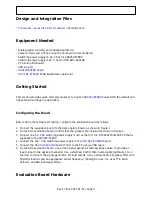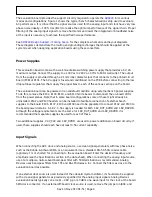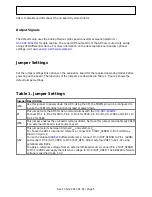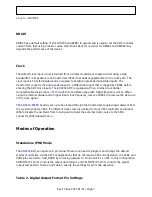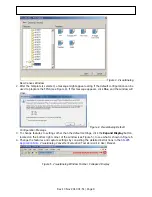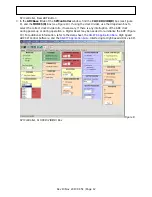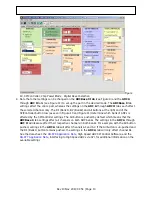
Rev 13 Nov 2013 01:51 | Page 5
C810, to disable and disconnect the on-board crystal oscillator.
Output Signals
The default setup uses the Analog Devices high speed converter evaluation platform (
HSC-ADC-EVALDZ
) for data capture. The serial LVDS outputs from the ADC are routed to J1 and J2
using 100Ω differential traces. For more information on the data capture board and its optional
settings, visit
www.analog.com/hsadcevalboard
.
Jumper Settings
Set the jumper settings/link options on the evaluation board for the required operating modes before
powering on the board. The functions of the jumpers are described in Table 1. Figure 2 shows the
default jumper settings.
Table 1. Jumper Settings
Jumper Description
J204
Use this jumper to power down the ADC. Using the SPI, the PDWN pin can be configured to
invoke the STBY (standby) function instead of power down.
P1
This jumper sets the ADC for SPI communications with the
HSC-ADC-EVALDZ
.
Connect Pin 1 to Pin 2 for SDIO, Pin 4 to Pin 5 for SCLK, Pin 8 to Pin 9 for CSB1 and Pin 11 to
Pin 12 for CSB2.
J804
This jumper enables the on-board crystal oscillator. Remove this jumper (and optimally C810)
if an external off-board clock source is used.
J202
This jumper selects between internal V
REF
and external V
REF
.
To choose the ADC's internal 1V reference, connect Pin 3 (DUT_SENSE) to Pin 5 (GND) as
shown in Figure 2.
To use the on-board
AD822
buffered reference, connect Pin 2 (DUT_SENSE) to Pin 1 (AVDD),
and connect Pin 4 (DUT_VREF) to Pin 6 (EXT_REF). Adjust external VREF to be 1.0V using
potentiometer R202.
To apply a reference voltage from an external off-board source, connect Pin 2 (DUT_SENSE)
to Pin 1 (AVDD) and apply the reference voltage to Pin 4 (DUT_VREF). The AD9249 reference
voltage is specified to be 1.0 V.



